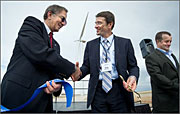- Number 337 |
- May 16, 2011
NREL adds giant wind turbine to research site

NREL's Deputy Laboratory Director
Dana Christensen, left, shakes
hands with Andy Geissbuehler,
VP & General Manager of Alstom
Power's Wind Business North
America, at dedication ceremonies
for the Alstom Eco 100 wind turbine.
On the right is Steve Chalk, the
Department of Energy's Deputy
Assistant Secretary for Renewable
Energy and Energy Efficiency.
Credit: Dennis Schroeder
Blades longer than a basketball court, a tower the length of a football field, the 3-megawatt Eco 100 is the latest — and largest — wind turbine behemoth erected at DOE’s National Renewable Energy Laboratory (NREL).
Built by French power-generation company, Alstom, the Eco 100 is being tested at NREL’s National Wind Technology Center (NWTC) near Boulder, Colo., so it can be certified for use in the United States. Its certification will mean good-paying jobs in the United States for years to come, and what is learned during testing will bring the nation closer to DOE's target of 20 percent wind energy by 2030.
Alstom paid for the project and will benefit from the information the tests provide, but NREL and America as a whole also will benefit.
The cooperative research and development agreement signed last May between Alstom Power and NREL is being extended to include ongoing tests. Later, the public-private partnership could be extended to include research on off-shore turbines.
Alstom is building a manufacturing plant for the nacelles — the cigar-shaped enclosures attaching the tower to the blades — for the Eco 100 in Amarillo, Texas. The plant will open this fall and create and maintain 275 American jobs, NWTC Director Fort Felker said. A single Eco 100 is powerful enough to supply energy to 2,000 homes and, with expected service life pegged conservatively at 20 years, could easily generate revenue in the tens of millions of dollars.
The tests are measuring power performance, power quality, noise, and system frequency. Success in those tests already has given Alstom the IEC certification of its 60Hz model it needs to start sales and production in the United States. Ongoing tests will create a sophisticated engineering simulation model of the Eco-100 drive train.
NREL is measuring inflow conditions, including wind speed wind direction and air pressure and temperature, on a large meteorological tower at its National Wind Technology Center. NREL also is measuring voltage and current at 1Hz to establish a power curve — a plot of power versus wind speed. In addition, the tests will measure voltage and current fluctuations for their impact on the power grid.
Instruments at the base of the tower measure pressure under the foundation and the strain inside the foundation. The tests are aimed at checking the assumptions in the design and optimizing the design of the foundation.
The NWTC is the most extensive wind-turbine testing facility in the nation.
The Alstom Eco 100 turbine employs a novel drive-train design that isolates the gearbox from rotor loads, putting less strain on the gearbox. That is a promising difference-maker because the wind industry worldwide has been addressing the problem of gearbox reliability for several years. NREL heads a consortium of turbine manufacturers, utilities and suppliers, the Gearbox Reliability Collaborative, that examines ways to improve designs and retrofits for gearboxes.
"This has the potential to greatly improve gearbox reliability," Felker said. "Through this project with Alstom, NREL will develop a comprehensive understanding of this innovative drive-train topology."
Never has a wind turbine churned wind as high above the ground at the NWTC as the 3-MW Eco 100. How big is it?
At its base, the 300-foot (90-meter) tower is about 14 feet (4.5 meters) in diameter.
The entire turbine weighs about 600 tons, with each of the three blades weighing about 11 tons, said Rodrigo Vallejo Paez, project manager for Alstom. The 33-foot by 16-foot (10-meter by 5-meter) nacelle, which cradles the gear box and other instruments high up on the tower, weighs 95 tons.
Alstom hired Michels Wind Energy to install the turbine. Stage-by-stage, one of the largest cranes in the world, lifted turbine parts above the short-grass prairie of rural Boulder County, Colo., in the shadow of the Rocky Mountains in December.
Wind energy has been one of the fastest-growing segments of the U.S. electrical system for many years, and will be an essential part of the transformation to clean energy, Felker said.
Jeroen van Dam, NREL's project manager for the Alstom project, agrees. "Wind power is a clean energy source that can be rapidly deployed, is abundant and creates manufacturing jobs," he said. "It is already cost-competitive with fossil fuels in a lot of locations and it doesn't use any water."
Learn more about wind research at NREL.
[Bill Scanlon, 303-275-4051,
william.scanlon@nrel.gov]
